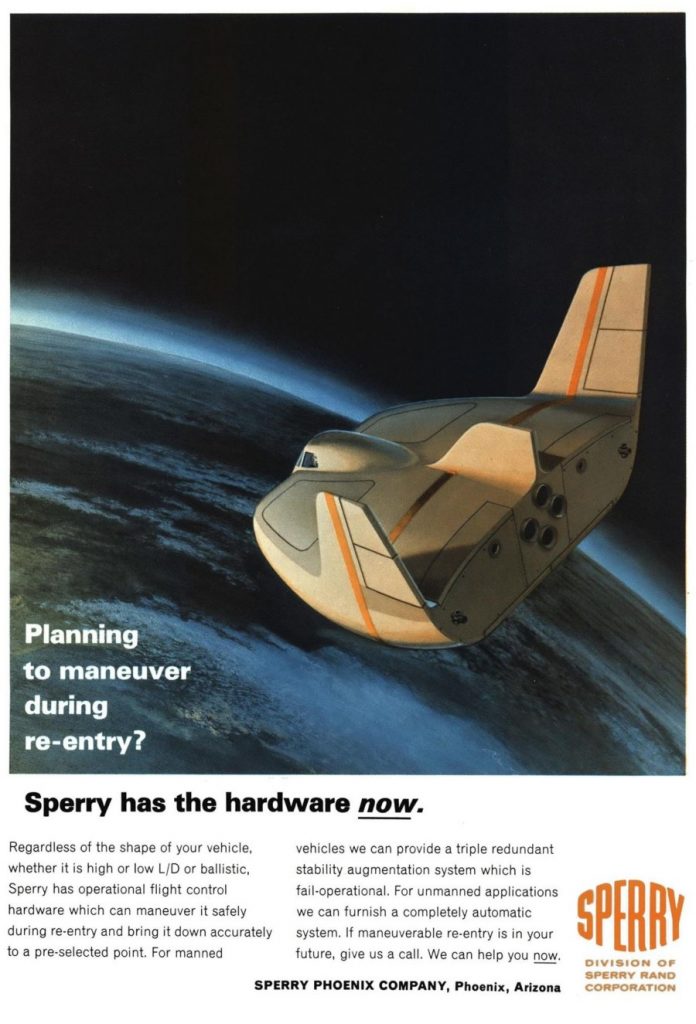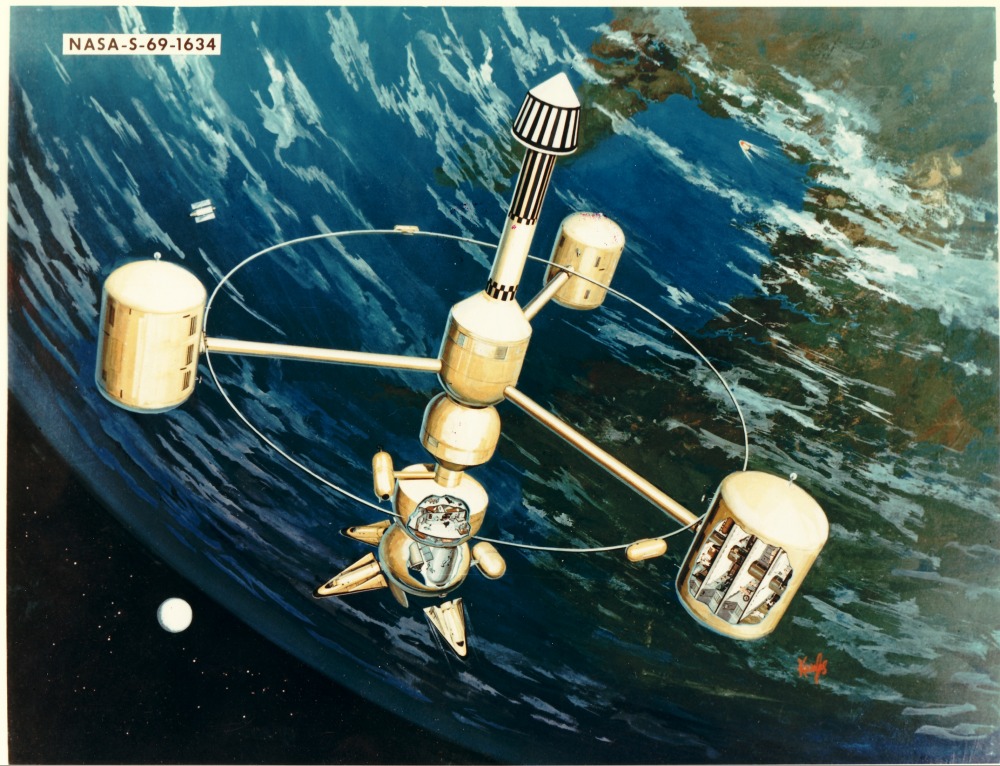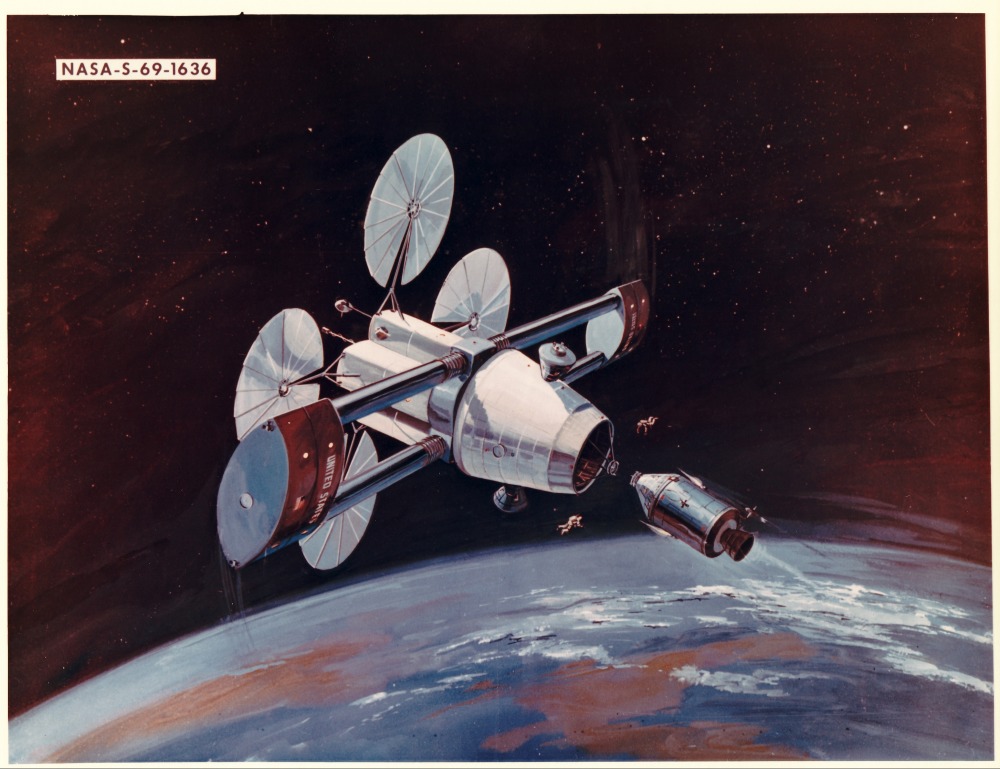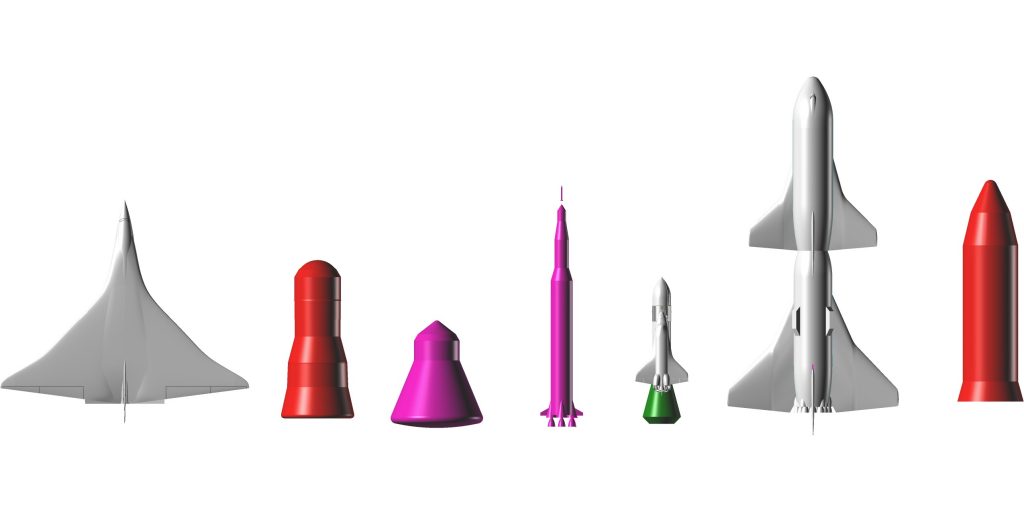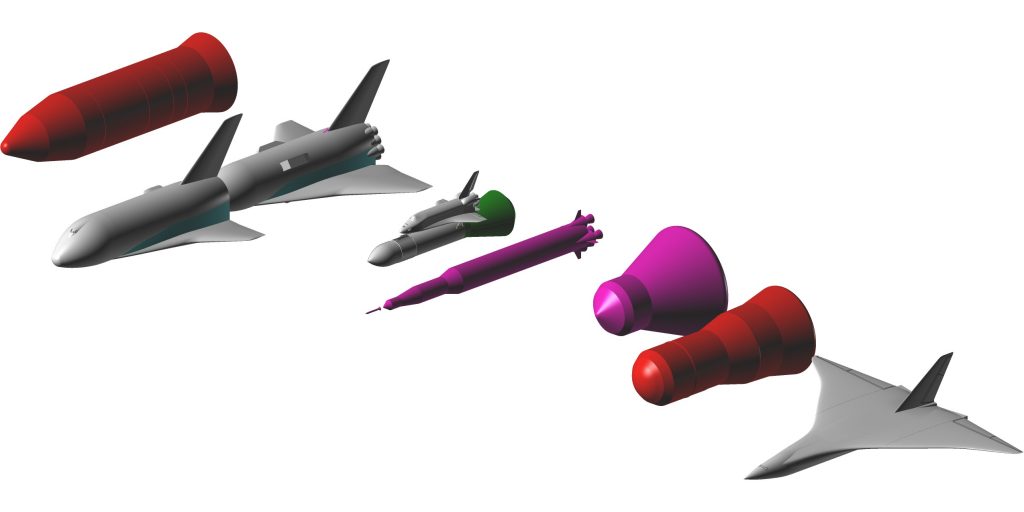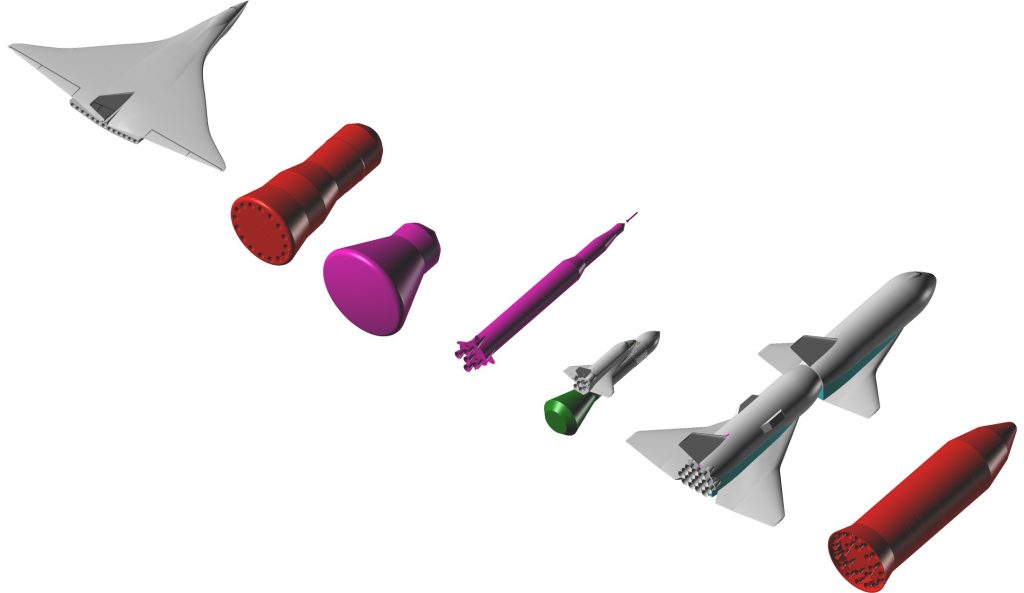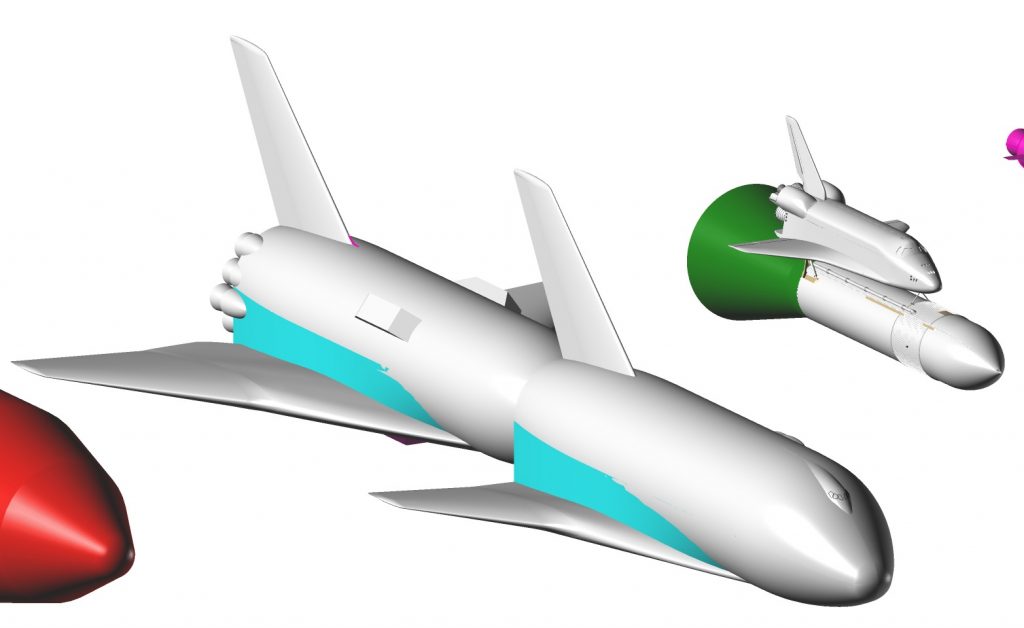A magazine ad from 1966 depicting a lifting body in space. The design seems reasonable 9sort of a cross between the M2and the HL-10) but could very well be a product not of engineers but of the art department. The angle is not the most informative, but it appears that this design has something of a squared-off nose. Note that the cockpit canopy is exposed, something that very few small lifting body designs had… for the simple reason that the windows would likely melt during re-entry, and that would defeat the purpose in making the thing recoverable. As vehicles get bigger, such as the space shuttle, the windows get further away from the nose and can be made survivable. But little designs like this? not very likely with 1960’s tech. Otherwise, though, it is an attractive illustration.
D’oh.
The first prototype of #Starship hopper will take a few weeks to repair. 50 mph winds broke the mooring blocks late last night & fairing half was blown over.
photos 20 min ago :/ #SpaceXBest of luck to all the hardworking @SpaceX teams. ♡ Y'all got this! pic.twitter.com/JfRX86TyyG
— Evelyn Janeidy Arevalo (@JaneidyEve) January 23, 2019
Additionally, the Blue Origin New Shepard made it officially to space:
Bonus: Popular Mechanics interview with Elon Musk where he describes using methane or water transpiration cooling for the Starship stainless steel structure during re-entry.
The aircraft in search of a mission loses its mission:
Stratolaunch abandons launch vehicle program
“Stratolaunch is ending the development of their family of launch vehicles and rocket engine,” the spokesman said in an emailed statement. “We are streamlining operations, focusing on the aircraft and our ability to support a demonstration launch of the Northrop Grumman Pegasus XL air-launch vehicle.”
Yeah… I’m sorry, but developing an over-sized aircraft to launch the under-sized and over-priced Pegasus XL? Not a good business model. This news pretty well confirms that this was a “vanity project” by billionaire Paul Allen. When he died in October, the management of his companies and projects passed into the hands of people more interested in profit than whatever dreams he had. This should be a cautionary tale for the likes of Musk and Bezos… get their own dream projects running, successful, and *profitable* just as soon as they can. Because the moment they are gone… the dream dies.
As there is likely not a museum big enough for the Stratolaunch, I expect it will be broken down for parts before too long.
Space junk it becoming a bit of a problem. With half a million bits of trash currently being tracked, and far more to come in the near future, low Earth orbit could potentially become a dangerous place to be. There have been lots of plans proposed to deal with space junk, from lasers used to ablate the leading faces of small bits to cause them to deccellerate and deorbit, to satellites that would grab other, dead satellites and drag them down to their firey dooooom. But with hundreds of thousands of bits being tracked, and millions of bits too small to track, something a bit broader might need to be tried.
As with a lot of environmental cleanup plans, a big issue here is that cleaning up LEO will cost money but not necessarily generate income. But what if it could?
Assume that the SpaceX Starship and Super Heavy come to pass. The Starship is supposed to be able to take a jetliners worth of passengers to Mars… but only a small percent of that number could sit at sizable windows at any one time. So… modify a Starship specifically for short-duration space tourism, with the number of passengers dictated not by mass but by how many could sit at the window all at once. And instead of going to orbit, the Starship simply goes *up.* So, what about the wasted payload potential? Water. Lots and lots of water. As the Starship coasts through space, it sprays out a fine mist of water, creating a cloud of water vapor at the *altitude*of low Earth orbit, but not the *velocity*of low Earth orbit. The cloud would of course follow the ship both up and down, spending a matter of minutes in space. Any small bits hitting the cloud will be substantially slowed, perhaps enough to fall out of orbit almost immediately; larger satellites would of course also be affected, so timing would be important.
This suborbital hop could be straight up, leaving a cylinder of vapor perhaps many hundreds of miles high. The Starship could also launch from, say, California to land in Florida; the maximum altitude reached would be lower, but the duration in space would be longer. And the return trip from Florida to California would result in much higher impact velocities between space junk and the cloud. North-South flights would put a long “net” across equatorially orbiting bits.
SpaceX has said that they think they can fly the Starship to orbit for something like $10 million. A suborbital hop filled not with rocket fuel but water should be substantially cheaper. If this sort of suborbital hop could fly for $5 million and carry 20 passengers, that means that each passenger could pay $250,000 for both the short bit of suborbital tourism… and get the satisfaction of cleaning up a bit of space.
Further benefits could be had if the water wasn’t purely water, but had some sort of “reflectant” in it. As the cloud came back down, it would hit the upper atmosphere and smear out across it, leaving, for a time, a high altitude cloud that would reflect sunlight back out into space, aiding with that “global warming” thing.
Yesterday the Trump Administration announced that the US is going to get back into the “Star Wars” business. Not to the scale of the original Strategic Defense Initiative days, when the goal was to put a dent in a Soviet full strike, but to knock down a strike from the likes of Iran or North Korea or Canada.
“Star Wars” Lite? We Explain Trump’s Missile Defense Strategy
A direct link to the Missile Defense Review is HERE. Ideas include F-35’s and drones armed with lasers and/or interceptor missiles to do boost phase interception… which would, of course, require that the aircraft be on-station near the launch site as it happens. This might work for the likes of North Korea or Iran, but wouldn’t be valuable against Russian or Chinese land or sea based ICBMs. For those, they also want to use space based interceptors. Yay! If the US actually goes ahead and fields a flock of Brilliant Pebbles, as was planned late in the SDI days, it will require a *lot* of low-cost launch capability.
It ain’t gonna happen, of course.
Stratolaunch airplane nears first flight
On Jan 9, the giant Stratolaunch plane did a taxi test that reached a top speed of 219 kilometers per hour (137 mph), and the nosewheel rotated off the ground. Flight tests probably aren’t far off.
I remain a little baffled about the business plan for Stratolaunch, especially since the initial payload is apparently supposed to be *three* Pegasus XL launch vehicles. That eems an odd thing to do. But Stratoluanch intends to eventually build their own better-optimized expendable and reusable launch vehicles. And the more launchers, the better.

Two pieces of NASA-marked (but likely not NASA-produced) concept art from the 1960’s depicted artificial-G space stations.
The first station (previously presented here in black and white not so long ago) depicts a substantial three-armed station witha multi-segment spine and three habitats. At one end of the spine is a nuclear reactor and its radiator; at the other end is a presumably rotationally0decoupled docking section. There is also an external “track” with two cars seemingly to provide transport from one habitat to another; it doesn’t really seem like this would provide a substantial improvement in transport over simply taking an elevator from one hab up to the spine and then down another elevator to the destination hab.
This space station, which appears from the art style to be a Grumman design, is a single-launch space station to be launched atop a Saturn V. The two arms would fold back for storage on the launch vehicle and would deploy once in orbit. An Apollo CSM is shown approaching for docking along the centerline; it’s not clear if the docking cone was rotationally decoupled. if it was not, the two Apollo-like capsules hanging off the sides of the cone are a bit of a head scratcher.
Both renderings have been uploaded in their full resolution to the 2019-01 APR Extras dropbox folder. This folder is available to APR Patreon Patrons and APR Monthly Historical Documents Program subscribers at the $4 per month level and above.
Kudos to China for doing what the US *should* have done 40 years ago but refused to do.
China’s Chang’e-4 makes historic landing on Moon’s far side

The Atlas rocket was a “balloon” of thin metal. It was only able to stand up on the pad – never mind accelerate in flight – because internal pressure kept the structure from collapsing. But if that pressurization fails…
Continuing to rough out some Heavy Lift Launch Vehicle CAD models. Instead of lumping them all together I’m breaking them into “genres,” partially because my computer is starting to balk at the the size of the full collection. Below is the “Solar Power Satellite Launchers” collection. Included, from left to right, Rockwell Star Raker, Boeing TSTO, Boeing “Big Onion” SSTO, Saturn V, NASA Personnel Launch System ( a Shuttle derived design), Boeing Space Freighter, NASA-JSC HLLV. There are a few more designs that could probably be added to this collection. Suggestions?
As previously indicated, there is a good chance of a 1/288 scale model of some of the designs such as the Saturn V and the Star Raker. But *all* of them? Probably not in that scale. What seems reasonable is something akin to the old Monogram “missile collection” kits, with all of the HLLVs in something like 1/500 or 1/700 scale. A similar collection of Nova/Post-Saturn boosters is possible.
The Space Freighter would be substantially impressive in 1/288… but really rather enormous.
